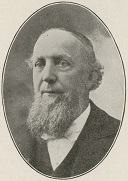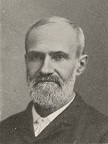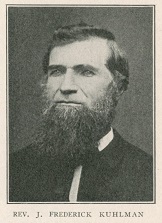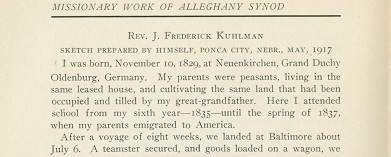
|
Rev.
J. Frederick Kuhlman |
|
Rev. J. Frederick Kuhlman |
[Editor's note: Rev. J. Frederick Kuhlman and his first wife, Louisa (Smith) Kuhlman, resided in the vicinity of Confluence, Somerset County, PA near her parents Garrison and Hanna (Younkin) Smith. His wife's tragic death in 1853, at the age of 20, left him with two young sons to raise just as he was beginning his Christian ministry. This is his story, in his own words, published more than six decades later.]
I was born, November 10, 1829, at Neuenkirchen, Grand Duchy Oldenburg, Germany. My parents were peasants, living in the same leased house, and cultivating the same land that had been occupied and tilled by my great-grandfather. Here I attended school from my sixth year-1835-until the spring of 1837, when my parents emigrated to America.
After a voyage of eight weeks, we landed at Baltimore about July 6. A teamster secured, and goods loaded on a wagon, we started to Somerset County, Pa., by way of Gettysburg, Chambersburg and Bedford. A number of my uncles had preceded us to this country several years earlier, and lived then near Meyer's Mill (now Meyersdale). With the exception of my younger brother, the entire family walked from Baltimore to near Berlin, Pa., where our friends met us. In the fall of that year I started to school at Meyer's Mill, a subscription school, the common school system not having been adopted in that part of the country at that time.
In this neighborhood my parents remained for ten years, eight years in the same place near Meyer's Mill. They attended the Lutheran Church at Pine Hill until St. Paul's, or Fritz Church, was built. Here I attended catechetical instruction in the fall and winter of 1846 and 1847, being confirmed May 15, 1847, by Rev. Charles Young, pastor. (People persisted in calling and writing our name Coleman, so my confirmation certificate has the name of Frederick Coleman.) It was in the winter of 1845, at Wellersburg [Somerset County], where I was apprenticed to a carpenter, under the preaching of C. Lepley, then pastor at Frostburg. Md., that I was awakened to a sense of my sins, and sought and found the sinner's Friend. My parents were conscientious, devout, and deeply pious Christians, whose library of religious books consisted of the Bible, Arndt's True Christianity, and the German Hymn Book. There was family worship morning and evening, no matter what work was pressing or who was present.
|
|
| Rev. Kuhlman's autobiographical profile in History of the Alleghany Evangelical Lutheran Synod of Pennsylvania: Together with a Topical Handbook of the Evangelical Lutheran Church, Its Ancestry, Origin and Development, Vol. 1, by William Harrison Bruce Carney (Philadelphia: Lutheran Publication Society, 1918). |
I must omit any account of the strenuous efforts made to gain an education, and simply state that I began studying with a view to entering the ministry, in the spring of 1852, and was licensed to preach by Alleghany Synod at its meeting at Bedford, Pa., October, 1858. By direction of Synod, I took charge of what was then called the Jefferson Mission, now Summerhill charge, composed of four congregations -- Wilmore, Summerhill, Dunmeyer and Scalp Level. The salary was $250, besides $50 from Synod. We, however, declared ourselves self-sustaining at first meeting of Synod, and the support was proportionately increased by the congregation.
My labors were not confined to the four congregations, but extended to Lilly east; north of Summerhill, to Jackson, where a congregation was formed and a church built; and south of Scalp Level, in the neighborhood of where St. Thomas' now is, besides other points, usually preaching three times on a Sunday.
 |
| Rev. Henry Welty Kuhns, D.D. |
At meeting of Synod at Berlin, 1860, I was ordained. In 1862, the Mission Committee asked me to go as a missionary to Nebraska. Though inclined to go, on account of the war, I had to decline. In 1864, I was again asked to go. Circumstances having changed, I was able to accept the call, but desired to visit the field before removing my family there. No objection was made to my request, but I must bear my own expenses, to get the money for which, I sold my horse, and so went to Nebraska. I reached Omaha in June, and preached in Kuhn's church on Sunday following, and started to Fremont on Monday evening by stage to go to Fontenelle [Fontanelle]. From Fremont to Fontenelle, nine miles, I footed it, carrying my satchel. By wading the Elkhorn River, I reached my destination, and stopped with Henry Sprick, who afterward became well known in both Church and State.
There were two German settlements, one near Fontenelle, and the other eight or nine miles farther up the Elkhorn, the two numbering about twenty-four families. In company with Mr. Sprick, I visited every family, Mr. Sprick taking subscriptions for pastor's support, amounting to $330. July 4, I rode on pony to West Point, and found the town deserted. J. D. Neiligh, the proprietor, having departed with his family, there remained nothing of West Point but his empty shack and the unsheltered engine of a sawmill. Returning to Omaha, Rev. Kuhns took me to Dakota City, and from there to Ponca. At these places were small organizations. Dakota City had a good church building which is still standing, answering its purpose.
This trip, in open buggy, with such a companion as Brother Kuhns, who had passed over the same road many times, twenty-five miles of which lay through the Indian Reservation, was to me intensely interesting.
 |
| Rev. Samuel Aughey, Ph.D., LL.D. |
On my return home from this trip west, I had no expectation that I could go as missionary to Nebraska. Because of expenses connected with such an undertaking, and war-time "high cost of living," the amount of support from Synod and what would be received on the field would be insufficient for a living. But at the meeting of Alleghany Synod, in September, 1864, at Indiana, Pa., an increase in contributions, increased appropriations, and Rev. S. Aughey and myself were appointed as missionaries to the field I had visited -- he to Dakota City, and I to Fontenelle, Tekama, West Point, Columbus, and adjacent parts.
Myself and family left Wilmore [Cambria County], Pa., September 24, 1864. Went by river from Pittsburgh, via St. Louis. to Hannibal. Mo.; thence, via Hannibal & St. Joe Railroad, to St. Joe, where we embarked on the Missouri River for Omaha, not reaching our destination until the last of October. After the serious illness of the young woman who came with us as household help, and a little later the sickness and death of our little boy -- the expense of medical aid from Omaha being nearly $50 a trip -- I entered upon the work to which so great a part of my life has been devoted. Of this I cannot speak in detail, but shall attempt a brief summary of results.
Rev. H. W. Kuhns entered the territory late in 1858, organized and built a church in Omaha, built a church at Dakota City, organized congregations at Ponca and Fontenelle. After 1864, he confined his labors chiefly to Omaha, and left the field early in the '70s. I entered the field in 1864, perfected the organization at Fontenelle, and built the first church there. Organized on Logan Creek, at Tekama [Burt County], Salem Church in Dakota County, at West Point, two congregations in York County, organized at Red Cloud [Webster County]. Perfected the organization at North Platte, did pioneer work at Columbus and other points where afterward congregations came into existence.
Rev. S. Aughey came to Dakota City, December, 1864, and continued his work till 1870, when I succeeded him in that field, then self-sustaining.
Rev. Eli Huber came to Nebraska City in 1866, formed congregations at that and two other points, and built the church at Nebraska City, remaining until the field became self-sustaining.
Rev. W. I. Cutter was sent by Alleghany Synod to Plattsmouth, Nebr., in 1866 or 1867, but left before anything permanent was accomplished. He was transferred to the Kansas Synod in 1869.
Rev. J. G. Groenmiller entered the field in 1867, as stated in another place. The five missionaries sent out by Synod who continued long enough on the field are properly called the Lutheran pioneers of Nebraska.
In 1869, the Alleghany Synod turned its missions over to the General Synod. The support from the Synod during some years past had been insignificant, and after the transfer to General Synod, we had no outside aid for a number of years. Under such conditions, a vast field to be occupied, other denominations sending in money and men, the country settling up at an astonishing rate, we, left to our own resources, and dependent upon our own efforts, organized the Lutheran Synod of Nebraska, in September, 1871, at Omaha. There were seven of us, one not active in the ministry, Rev. Kuhns, having resigned at Omaha sometime before, declined to take part. I became the first president, but failed to get the members together until 1874. Five of us met at the second meeting, at Fontenelle; from that time on, Synod has met regularly and increased in membership, so that in 1890, at its meeting at Denver, Colo., where the Germans separated and formed the German Synod, there were eighty-one ministers connected with it, and over 4,000 communicants were reported.
At present the German Synod reports eighty-two ministers, a membership of 9,443, has a seminary at Lincoln, Nebr., and takes part in the support of Tabitha Home at that place. The English reports forty-nine ministers, 7,292 members, supports the Home and Midland College at Atchison, Kan.
Nebraska has over 56,000 Lutherans, more than 17,000 of which are connected with the English and German Nebraska Synods.
| Originally published in History of the Alleghany Evangelical Lutheran Synod of Pennsylvania: Together with a Topical Handbook of the Evangelical Lutheran Church, Its Ancestry, Origin and Development, Vol. 1, by William Harrison Bruce Carney (Philadelphia: Lutheran Publication Society, 1918). |
|
This page copyright © 2014 Mark A. Miner |

